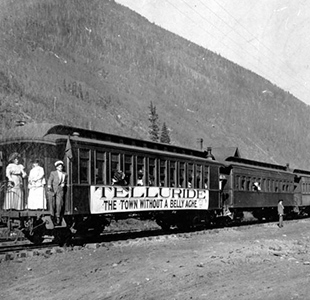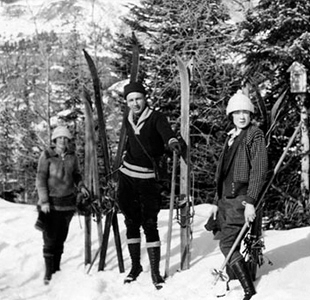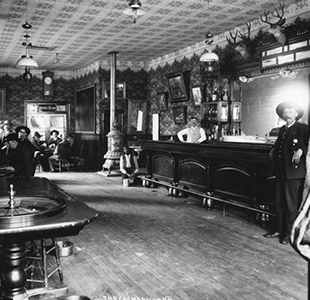Here are links to press releases about the Telluride Historical Museum and its programs. If you are a reporter and would like to learn more about the museum, we look forward to speaking with you about the museum!
Museum Announces New Executive Director

“MUSEUM ANNOUNCES NEW EXECUTIVE DIRECTOR”
Telluride, Colorado (March 22, 2012) – The Telluride Historical Museum today announced the hire of Erica Kinias as Executive Director effective April 1, 2012. Kinias will be replacing Lauren Bloemsma who recently resigned after holding the top post at the museum since April of 2005.
Kinias most recently served as Programs and Grants Manager for the Arizona Humanities Council and has held positions with the Chiddingstone Castle in Kent, England and at the Museum of London. She served as Board Secretary for the Central Arizona Museum Association and as an oral history transcriber and archivist. She has Masters Degree in Museum Studies from the University College London, and an undergraduate degree in History from Arizona State University.
“Kinias is a museum professional with a passion for community outreach,” said museum Board President, Deborah Freedman. “Lauren has set the museum on a great path and laid the groundwork for a smooth transition. Erica is a leader with the strength and vision to steer the museum forward and to the next level.”
Kinias and her husband, Thanasis, will relocate from Arizona, where Mr. Kinias teaches World History at a community college in Phoenix.
When Kinias first visited the Telluride Historical Museum, she felt immediately at home. In fact, she may even have discovered a distant relative in one of Telluride’s most famous residents: L. L. Nunn, a mine owner instrumental in bringing AC current electricity to Telluride. “We’re looking through our family tree,” said Kinias, whose maiden name is Nunn.
Kinias has worked for small museums before. For two years she managed an impressive and diverse collection of Egyptian artifacts; Japanese art and armor; medieval and early modern Buddhist art; and early British paintings and manuscripts at a country house museum in a community with only 17 people.
When Kinias visited Telluride during the interview process, she took the opportunity to ask around about the museum. “Complete strangers opened up to me. They all had wonderful things to say,” she said.
“Museums are magical. They connect people’s everyday lives with the past. I am honored to work with the museum’s talented and dedicated staff and board to share Telluride’s colorful past,” said Kinias.
Telluride Unearthed Lecture Features Author of Ground Breaking Book
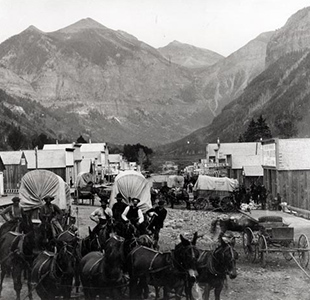
“TELLURIDE UNEARTHED LECTURE FEATURES AUTHOR OF GROUND BREAKING BOOK”
The Telluride Historical Museum, Pinhead Institute and the Crow Canyon Archaeological Center collaborate to shed new light on Ancestral Pueblo Indians with author, Scott Ortman.
San Miguel County, Colorado (March 20, 2012,) – If you follow the Dolores River, not far from Telluride, you’ll eventually find yourself at the heart of one of the world’s greatest archaeological areas: The Mesa Verde region of southwestern Colorado. Inhabited by American Indians for centuries—indeed millennia—this region has the highest concentration of archaeological sites anywhere in United States. The true identity of the ancient people of Mesa Verde and where they went when they migrated from the region at the end of the 13th century remained one of the enduring mysteries of world archaeology. Until now.
“Winds From the North,” a new book—and subject of Thursday’s Telluride Unearthed lecture, by anthropologist Scott Ortman—uncovers that great mystery.
Ortman’s book—according to Dr. Mark Varien, Research and Education Chair at Crow Canyon Archaeological Center— “is the most talked about new research in Southwestern archaeology in a long time.”
Thursday’s lecture will center on Ortman’s research, specifically a problem that has been baffling archaeologist for almost 100 years: What is the relationship between ancient Pueblo Indians and the present day Pueblo Indians of New Mexico and Arizona?
For tens of thousand years, Pueblo people lived in the four corners area, just outside of Telluride, in the 13th century, within a generation, the entire society collapsed and all the villages were vacated. Ortman points out that while many areas around the Southwest had populations that appear to have grown at the same time the pueblos of the four corners were being abandoned, the buildings and artifacts in the growing communities don’t show strong connections to those of the Mesa Verde region.
“The mystery has been how to account for the patterns that don’t add up,” said Ortman, who delved into Pueblo languages, oral traditions, biological variation and a variety of archaeological data sets to bring some order to the confusing mass of evidence.
Ortman said the most satisfying aspect of his work was his time talking with contemporary Pueblo people.
“Pueblo people have very strong and consistent ideas on how they came to be, and they do seem to be reflecting on events that happened in the 13th century in the four corners, it’s just the archaeological evidence doesn’t map onto those stories directly. The key to the puzzle of my work was to reconcile what the Pueblo people have been saying all along and what archaeologists believe based on the archaeological record of these events,” said Ortman.
Varien said, “both archaeologists American Indians are really excited about the new findings in the book,” which will be available for sale at Thursday’s Lecture. Ortman is the Lightfoot Fellow at Crow Canyon Archaeological Center and the Omidyar Fellow at the Santa Fe Institute.
Ortman is the only scholar currently integrating historical linguistics, human biology, archaeology, and oral tradition to better-understand the histories of non-literate societies.
The Telluride Unearthed lecture will be held at 6p.m. at the Telluride Historical Museum. Admission is $5. For more information, telluridemuseum.org.
The Telluride Unearthed Lecture Series is a product of the Telluride Historical Museum’s partnership with the Pinhead Institute and the Crow Canyon Archaeological Center.
Caption: Scott Ortman, Lightfoot Fellow at Crow Canyon Archaeological Center and the Omidyar Fellow at the Santa Fe Institute, will host a Telluride Unearthed lecture at the Museum on Thursday. His new book has been described as “the most talked about new research in Southwestern archaeology in a long time.”
Telluride Unearthed Lecture Features Author of Ground Breaking Book
March 2012Shedding new light on Ancestral Pueblo Indians with author, Scott OrtmanScrapple is About You
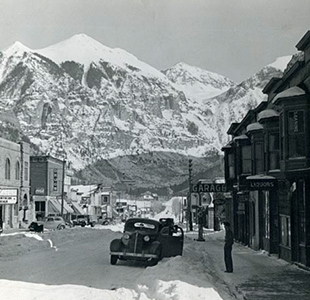
SCRAPPLE IS ABOUT YOU
The Telluride Historical Museum hosts annual screening of a cult classic film set in Telluride
Telluride, Colorado (March 13, 2012)– Life in Telluride is not completely unlike the movies. Consider the script in 1891, when the town (the first in the world) became illuminated by AC electricity. Or, a few years earlier, when a kid named Butch made off with $24,000 from a local bank. Imagine too the colorful cast at Popcorn Alley, town’s legendary Red-Light District.
On Thursday, March 15, the Telluride Historical Museum will host a special screening of “Scrapple,” a feature length film “New York Times Magazine” described as “Babe on Acid.”
Shot in under a month in 1996, “Scrapple” pokes at old-timers, realtors and drug selling ski bums in the 1970’s fictional town of Telluride, err, Ajax. The film includes familiar faces, including Ashley Boling, Bradley Blackwell, Ken “Striker” Grodberg and Christopher Hansen. Hansen, along with his brother, Geoffrey Hansen and George Plamondon wrote the film, which was inspired by a short story by another local, Sean McNamara.
For a dose of the stranger-than-fiction history of the 1970’s, pick up a copy of the museum’s new journal, “Telluride Tales,” an exploration of the decade that saw the birth of a ski resort and the death of mining.
The journal, just like the film, features a hodgepodge of young people trying to make their own way; trust funders burning money and time; real-estate entrepreneurs; old-timers; outlaws; drunks; pretty girls; and of course, a hippie hating Town Marshall.
Thursday’s screening of “Scrapple” is a fundraiser for the museum. Tickets are $10 and the show starts at 9p.m.
Scrapple is About You
March 2012The Telluride Historical Museum hosts annual screening of a cult classic film set in TellurideMuseum Hosts Traveling Exhibit

MUSEUM HOSTS TRAVELING EXHIBIT
The Telluride Historical Museum celebrates agricultural life, art and regional traditional artists.
Telluride, Colorado (February 07, 2012) – Harvest of Heritage, Colorado Masterpieces: Celebrating Agricultural Life and Art, an exhibit honoring over two dozen of Colorado’s master traditional artists, will open at the Telluride Historical Museum on February 16 with a special reception for museum members.
The exhibit has traveled across the state and was even displayed at the Colorado State Fair.
Harvest of Heritage includes wheat art, leather and rawhide braiding, Mexican fabric art, woodcarving, Japanese paper art and ornamental iron work. An interpretive display features photographs and information about those and many other art forms including stained glass work, quilt making, painting and weaving. All of the featured artists have links to Colorado’s rich agricultural heritage and their stories bring our state’s history to life.
Having met the highest standards of the Colorado Creative Industries’ Cultural Heritage Program, many of the featured artists have been awarded state grants and fellowships to help them preserve, present, and celebrate their traditional art forms. Two have received the National Endowment for the Arts’ highest honor for our nation’s tradition bearers, and many serve as master artists passing on skills and knowledge to the next generation of apprentices.
The exhibit also includes photos and information about projects—supported through Colorado Creative Industries’ various grant programs—which contribute to the preservation and promotion of Colorado’s cultural heritage.
In attendance for the Exhibit Opening will be Ronna Lee Sharp, the exhibit’s curator and one of Colorado’s three regional folklorists.
Harvest of Heritage is presented by Colorado Creative Industries, funded by the National Endowment for the Arts American Masterpieces Program and created and toured by the Museum of Western Colorado.
Harvest of Heritage will be on display until the museum closes at the end of the ski season.
Museum Hosts Traveling Exhibit
February 2012The Telluride Historical Museum celebrates agricultural life, art and regional traditional artists.39 Years of the Ski Resort Celebrated

39 YEARS OF THE SKI RESORT CELEBRATED
Greg Stump’s long-awaited final cut of “Legend of Aahhh’s,” to premiere.
Telluride, Colorado (January 31, 2012) – The Sheridan Arts Foundation, Telluride Historical Museum, Bootdoctors and Travis Julia Presents will celebrate the Telluride Ski Resort’s 39th anniversary, at the Sheridan Opera House, on February 9 and 10 with two nights of special guests and world premieres, including a highly anticipated debut of a Greg Stump original ski film.
The first of the two premieres will debut “Super Cut: 39 Years of Telluride in Ski Movies,” an epic montage of ski footage shot in and around Telluride, vintage commercials and movie scenes featuring locals. Dean Rolley, Telluride’s resident Audio Visual guru, has spent months splicing together footage along with local ski film icon Scott Kennett and Travis Julia.
“We’re going to unveil some really good stuff, including the Winter Olympic Visa commercials; three different beer commercials and an MTV video featuring Roudy Roudebush as a pilot and a cameo from Ruby the mountain lion,” said Rolley.
Films featured in “Super Cut,” include a spattering of Warren Miller classics; “Scrapple,” a fictional story set in Telluride; and Greg Stump’s “The Good, The Rad, and The Gnarly,” “Maltese Flamingo,” and “Blizzard of Aahhh’s.”
Rolley, who boasts an impressive library of his own, received additional gems from the archives of Scott Ransom and Tim Territo.
Kennett, famous for skiing in films alongside his dog Zudnick, and Stump, who helped put the ski resort on the map, will be in attendance to introduce segments.
The following night, February 10, Stump will unveil his long-awaited, semi-autobiographical “Legend of Aahhh’s.”
Stump is best known for his 1988 flick, “Blizzard of Aahhh’s,” which prominently featured Telluride and was voted “Number One Ski Film of All Time,” by the Ski Channel and Skiing Magazine.
Stump’s films are widely credited for moving ski films from the documentary genre and into the action film genre.
“Blizzard of Aahhh’s” started it all!” said Travis Julia. “It was not only the first glimpse of extreme skiing, but a window into the future of skiing movies.”
Twenty five years after his breakthrough film, Stump returns to his stomping grounds to explore the history of ski film—from Leni Riefenstahl’s first ski movie in the 1930’s through today’s sponsor-drenched, high-definition thrillers—and document the influence the genre has had on big-mountain skiing, pop culture, and the birth of the extreme sports movement.
With interviews from Warren Miller, Dick Barrymore, Otto Lang, John Jay and Klaus Obermeyer, paired with ski turns from Scot Schmidt, Glen Plake, Mike Hattrup, Lynne Wieland, and others; Stump’s latest film promises to shed new light on the evolution of skiing and ski film production.
And with a soundtrack from Lukas Nelson and Promise of the Real—that’s Willie Nelson’s 22 year-old prodigal son and his ripping band—Fort Knox Five, and Bran Van 3000, “Legend” is in a genre of its own.
Tickets are $15 a piece per night and benefit the Sheridan Arts Foundation and Telluride Historical Museum. Shows are general admission, and all ages are welcome. Tickets can be purchased online at sheridanoperahouse.com or by calling the Sheridan Opera House box office at 970.728.6363 x5.
39 Years of the Ski Resort Celebrated
January 2012Greg Stump’s long-awaited final cut of “Legend of Aahhh’s,” to premiere.The Roots of Modern Civilization, in Our Own Backyard

THE ROOTS OF MODERN CIVILIZATION, IN OUR BACKYARD
Telluride Historical Museum and Pinhead Institute offer lecture on Mesa Verde’s Neolithic Revolution
Telluride, Colorado (January 16, 2012) – Perhaps the world’s best documented case of the Neolithic Revolution, which marked the shift from hunting and gathering to agriculture—possibly the most important transformation in human history—can be found in our own backyard: southwestern Colorado’s Mesa Verde region.
On Thursday, the Telluride Historical Museum and Pinhead Institute will host a Telluride Unearthed lecture exploring the roots of modern civilization in the Mesa Verde Region. During the vast majority of our time on earth, humans subsisted by hunting wild animals and collecting wild plants. About 10,000 years ago, people created the first domesticated foods. Agriculture developed independently in places like Papua New Guinea, Asia, the Middle East, Africa and the Americas, and specifically at Mesa Verde, where maize farming was introduced.
Dr. Mark Varien, Chair of Research and Education at the Crow Canyon Archaeological Center in Cortez, Colorado, will host the lecture. His work in the Mesa Verde region dates back to 1979. “The Pueblo Indians are some of the world’s most innovative and resilient societies,” said Varien.
The Crow Canyon Archaeological Center has conducted research into the deep history of Pueblo peoples since its founding in 1983. The origins of Pueblo society in the Mesa Verde region is the focus of the Center’s newest research initiative: The Basketmaker Communities Project, a multi-year excavation project focused on a dense concentration of sites dating to the Basketmaker III period (A.D. 600 – 725).
“We’ll be discussing the era when the first public architecture—great kivas—were invented. These buildings were used for community activities rather than domestic activities,” said Varien.
The Center’s plans include excavations at the Dillard Site, the location of the only known great kiva in the Mesa Verde region. Varien will speak about the project, share what deep Pueblo Indian history is being uncovered and discuss what the new research tells us about the Neolithic Revolution.
Telluride Unearthed is a collaborative lecture series intended to illuminate history through the lens of science. 2012 marks the seven years of collaboration between the museum and the Pinhead Institute.
The lecture begins at 6p.m., at the museum. Admission is $5. For more information visit telluridemuseum.org.
The Roots of Modern Civilization, in Our Own Backyard
January 2012Telluride Historical Museum and the Pinhead Institute offer lecture on Mesa Verde’s Neolithic RevolutionHistoric Ski Tour Offers Unique Perspective

HISTORIC SKI TOURS OFFER UNIQUE PERSPECTIVE
More than a host, Johnnie Stevens is the attraction
Telluride, Colorado (January 11, 2012) – “Who here has ever had trouble getting to Telluride?” Johnnie Stevens asked a captive audience at a recent Historic Ski Tour.
Stevens was on his way to make one his favorite points: the more things change, the more they stay the same.
He executed the parody flawlessly—with an anecdote about a woman, 100 years ago, who finally arrives in Telluride, by train, in a condition she didn’t start off in: on the verge of childbirth.
Stevens is well-suited to share Telluride’s story. A life-time local, Stevens grew up skiing town’s only rope tow, powered a car engine. With time, Billy “Senior” Mahoney, 20 years his elder, would call Stevens’ parents to ask if their son could ski the back country with him.
“Johnnie Stevens is more than the host of the tours,” said Lauren Bloemsma, executive director of the Telluride Historical Museum, “he is the attraction.”
When the resort opened in 1972, Stevens was called on, along with Mahoney, to take on lead roles. Eventually Stevens would serve as Chief Operation Officer and in 2004 he was inducted into the Colorado Ski and Snowboard Hall of Fame.
Historic Ski Tours are sponsored by the museum and The Peaks Resort and Spa. They’re free to the public, with a lift ticket, and leave The Peaks ski in/out location at 10 a.m. Tours are offered nearly every Monday. Tours last two hours and cover intermediate terrain.
IF YOU GO: Most Mondays 10a.m. Meet at The Peaks RSVP 970-728-3344x 2
Historic Ski Tour Offers Unique Perspective
January 2012More than a host, Johnnie Stevens is the attractionCrawl Back in Time
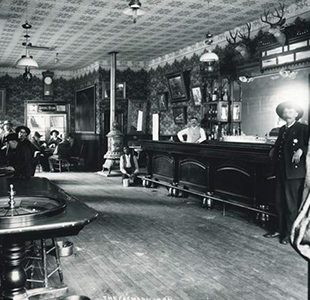
CRAWL BACK IN TIME
The Telluride Historical Museum presents a Historic Pub Crawl.
Telluride, Colorado (January 9, 2012)– During Telluride’s most raucous era—around the turn of the last century—there was an unwritten rule that required a woman to enter through the side service door at the New Sheridan where she would then be held, in a waiting parlour, until her date was ready to dine.
Other Sheridan rules—Don’t shoot the Pianist!—were posted in plain site.
Throughout prohibition, it wasn’t uncommon for as much as nine tons of sugar to come through town without any of it making it to a grocery store. Telluride Whiskey, after all, was in high demand, even as far away as New York, or so claimed some proud Moonshiners.
During another infamous chapter in Telluride’s liquid history—the1970’s—the Gypsy Moon Saloon (today’s Fly Me to the Moon) boasted a full bar with a laundry-mat to boot.
On Thursday, the Telluride Historical Museum, with help from Telluride Theatre, will illuminate the town’s liquid history with a four-stop tour of Telluride’s most infamous haunts.
The Crawl kicks off with a free beer at the Telluride Historical Museum. Afterward, revisit the decade that gave birth to the ski bum at the Fly Me to the Moon Saloon; tour the Sheridan Opera House, from the basement bath-house to the top level Vaudeville Bar; and finish at the New Sheridan Bar to discover the sacred and holy battleground of the Western Federation of Miners. All the while, special guests bring to life the long forgotten characters, stories and traditions of Telluride’s pioneer drinkers.
Tickets include a guided tour and beer stein with historic image. Drinks (accept the first one, at the museum) are not included. Hangovers are on the house!
RSVP: 728-3344×2 or email beth@telluridemuseum.org.





